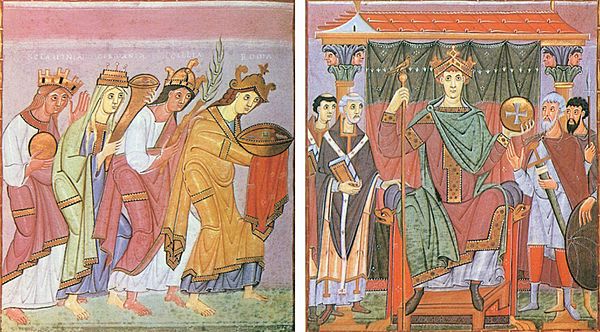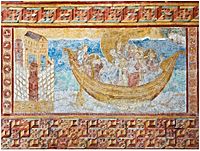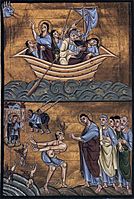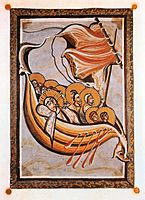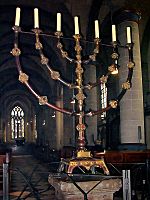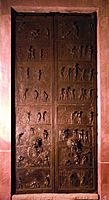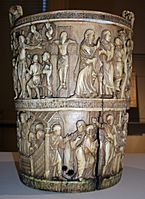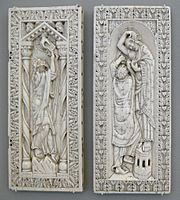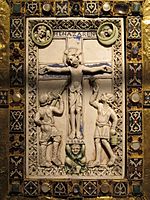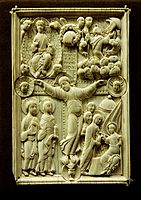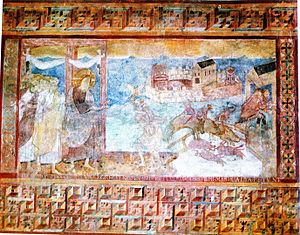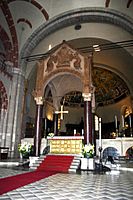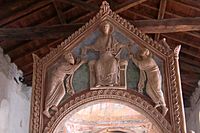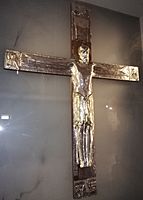Ottonian art facts for kids
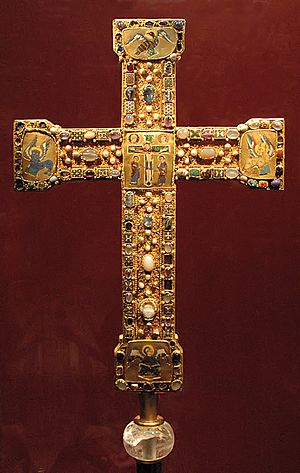
Ottonian art is a special art style from a time called the Ottonian Renaissance. It was popular in Germany, parts of Italy, and France between about 950 and 1024. This art style is named after the Ottonian dynasty, a family of kings and emperors who ruled during this time, like Otto I, Otto II, and Otto III.
Ottonian art came after Carolingian art and before Romanesque art. It was mostly religious art, found in beautiful illuminated manuscripts (hand-written books with pictures) and amazing metalwork. This art was usually made in important monasteries and for the emperor's court.
The style of Ottonian art is often grand and strong. It can be very expressive, showing deep feelings. Artists used bright colors and flowing lines to create powerful images.
Contents
Why Ottonian Art Was Important
Ottonian art was created during a time when the Holy Roman Empire was becoming strong again under the Ottonian rulers. This led to a new interest in culture and art. Artists combined ideas from older styles, like Late Antiquity (ancient Roman times), Carolingian art, and Byzantine art.
The rulers wanted their art to show how powerful they were. They also wanted to connect themselves to famous Christian emperors from the past, like Constantine and Charlemagne. They did this by including images of themselves in their art, often surrounded by symbols of their power.
Sometimes, artists even used old materials, like columns from ancient Roman buildings, in their new churches. This helped show that the new empire was just as important as the old ones.
Amazing Manuscripts
Ottonian monasteries were famous for making incredible illuminated manuscripts. These books were a major art form. Emperors and bishops often paid for them, so monasteries had the best artists and materials. Most of these books were religious texts, like gospel books.
These special books often had rich covers made of gold, jewels, and ivory. When they were carried in church parades, the covers were shown off, not the pages inside.
One important group of manuscripts is called the "Reichenau school." These books were likely made at the island monastery of Reichenau in Lake Constance. The Reichenau school was known for its beautiful gospel books and other church books. Some of these were made for the emperors themselves. In 2003, the Reichenau manuscripts were added to the UNESCO Memory of the World list because they are so unique.
The Reichenau school had different styles. One famous artist, called the Gregory Master, worked in Trier. His art was very detailed and showed figures in a graceful way. Another style, the "Liuthar group,", was more dramatic. It used flat shapes and strong gestures, with backgrounds often made of solid gold. This style helped create a visual language that was used across Europe in the Middle Ages.
Christ Calming the Storm in Art
This scene, where Jesus calms a storm, was often shown in Ottonian art. Many paintings show Jesus twice: once sleeping in the boat and then again as he calms the waves.
-
From the Hitda Codex, made in Cologne after 1000.
Shiny Metalwork and Enamels
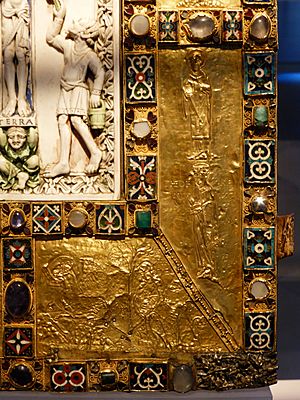
Many beautiful objects for churches were made from gold and decorated with gems, enamels (colorful glass melted onto metal), and crystals. These included crosses, reliquaries (containers for holy relics), and covers for important books.
Ottonian metalwork often had very detailed decorations. Gems were sometimes raised up on small gold towers, and gold wire was used to create patterns. The gems were not just for beauty; people believed they had special powers.
Important examples of these works include crosses from the Essen Cathedral Treasury, like the Cross of Otto and Mathilde. The Imperial Crown of the Holy Roman Empire in Vienna is another famous piece.
Artists also made large objects from bronze. At Hildesheim Cathedral, Bishop Bernward (who died in 1022) oversaw the creation of amazing bronze works. The most famous are the Bernward Doors, which show Bible stories in bronze relief. Each door was cast in a single piece! There's also the Bernward Column, a tall bronze column with scenes from the life of Jesus winding around it, like a giant scroll.
Around 980, a workshop in Trier became known for its cloisonné enamel work. This technique involved creating outlines with thin metal strips and then filling the spaces with colorful enamel.
Bronze Art Examples
-
The Expulsion of Adam and Eve from the Bernward Doors at Hildesheim Cathedral.
Carved Ivory
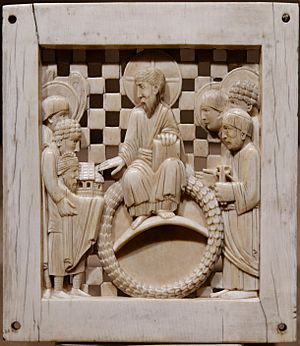
Many small, detailed sculptures were made from ivory during the Ottonian period. These were often oblong panels used to decorate book covers. The Crucifixion of Jesus was a very common subject.
A unique type of ivory carving from this time is the situla. These were special containers for holy water used in church ceremonies. Four Ottonian situlae are known, carved from whole elephant tusks. They are beautifully decorated with scenes and figures. The one in the Aachen Cathedral Treasury is especially grand, covered in jewels and showing an enthroned emperor.
A very important group of ivory plaques, called the Magdeburg Ivories, were probably made for Magdeburg Cathedral. These nearly square plaques show scenes from the Life of Christ. One plaque shows a crowned ruler (likely Otto I) presenting a model church to Christ. These plaques are known for their strong, simple figures.
-
Diptych panels showing Moses Receiving the Law and Doubting Thomas.
Wall Paintings
Many churches in the Ottonian period had large wall paintings, but very few have survived. Most of the ones we have are in poor condition or are just small pieces.
The church of St George at Oberzell on Reichenau Island has the most famous surviving wall paintings. These large scenes show the miracles of Christ. They are similar in style to the Reichenau manuscripts and are thought to be from around 980–1000. These paintings help show that Reichenau Abbey was a very important center for art.
Larger Sculptures
Very few large wooden sculptures from this period have survived. However, the huge painted figure of Christ on the Gero Cross (around 965–970) in Cologne Cathedral is a masterpiece. Its age was confirmed by studying the wood it's made from.
The Golden Madonna of Essen (around 1000) in Essen Cathedral is another rare and special piece. It's a smaller sculpture of the Virgin and Child made of wood covered with gold.
-
Gero Cross, around 965–970, Cologne Cathedral.
-
Stucco relief on the ciborium at Civate.
-
Cross of the Abbess Raingarda, 963-965, silver, in Pavia.
How We Know About Ottonian Art Today
Most Ottonian artworks that still exist were kept safe by the church. They were valued because of their connection to kings or important church leaders. Over time, some of the jewels on metalwork were taken or sold, so many pieces now have missing gems or modern replacements.
Many objects mentioned in old writings have completely disappeared. We probably only have a small part of all the art that was made back then.
The name "Ottonian art" wasn't used until 1890. After World War II, special art shows in Germany helped people learn more about this period, especially about metalwork, ivories, and enamels. These were considered the most important art forms of the time, along with manuscript illustrations.
See also
 In Spanish: Arte otoniano para niños
In Spanish: Arte otoniano para niños


